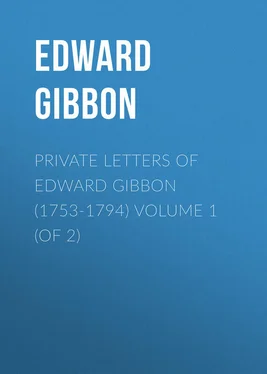Edward Gibbon - Private Letters of Edward Gibbon (1753-1794) Volume 1 (of 2)
Здесь есть возможность читать онлайн «Edward Gibbon - Private Letters of Edward Gibbon (1753-1794) Volume 1 (of 2)» — ознакомительный отрывок электронной книги совершенно бесплатно, а после прочтения отрывка купить полную версию. В некоторых случаях можно слушать аудио, скачать через торрент в формате fb2 и присутствует краткое содержание. Жанр: foreign_antique, foreign_prose, на английском языке. Описание произведения, (предисловие) а так же отзывы посетителей доступны на портале библиотеки ЛибКат.
- Название:Private Letters of Edward Gibbon (1753-1794) Volume 1 (of 2)
- Автор:
- Жанр:
- Год:неизвестен
- ISBN:нет данных
- Рейтинг книги:3 / 5. Голосов: 1
-
Избранное:Добавить в избранное
- Отзывы:
-
Ваша оценка:
- 60
- 1
- 2
- 3
- 4
- 5
Private Letters of Edward Gibbon (1753-1794) Volume 1 (of 2): краткое содержание, описание и аннотация
Предлагаем к чтению аннотацию, описание, краткое содержание или предисловие (зависит от того, что написал сам автор книги «Private Letters of Edward Gibbon (1753-1794) Volume 1 (of 2)»). Если вы не нашли необходимую информацию о книге — напишите в комментариях, мы постараемся отыскать её.
Private Letters of Edward Gibbon (1753-1794) Volume 1 (of 2) — читать онлайн ознакомительный отрывок
Ниже представлен текст книги, разбитый по страницам. Система сохранения места последней прочитанной страницы, позволяет с удобством читать онлайн бесплатно книгу «Private Letters of Edward Gibbon (1753-1794) Volume 1 (of 2)», без необходимости каждый раз заново искать на чём Вы остановились. Поставьте закладку, и сможете в любой момент перейти на страницу, на которой закончили чтение.
Интервал:
Закладка:
Footnote_31_31
Francis Egerton, third and last Duke of Bridgewater (1736-1803), with the assistance of Brindley, developed the canal system of the north of England.
Footnote_32_32
The Marquis of Tavistock, who married, in June, 1764, Lady E. Keppel, was killed in the hunting-field in 1767.
Footnote_33_33
John, second and last Earl of Ossory, married, in 1769, the Duchess of Grafton. Anne Liddell, daughter of Lord Ravensworth, married to the Duke of Grafton in January, 1756, was separated from her husband in 1765. Her daughter by Lord Ossory was born in 1768; her divorce from the duke, and her marriage with Lord Ossory, took place in March, 1769.
Footnote_34_34
The Treaty of Paris was signed February 10, 1763.
Footnote_35_35
Mr. Neville arrived in London with the Definitive Treaty, February 15, and at once had an audience of the king, which he describes in a letter printed in the Bedford Correspondence , vol. iii. p. 199.
Footnote_36_36
Claude Adrien Helvétius (1715-1771) published his materialistic book, De l'Esprit , in 1758. He married Mademoiselle de Ligneville, who survived him more than a quarter of a century.
Footnote_37_37
Madame Geoffrin (1699-1777), a woman of humble origin, the widow of a wealthy ice-merchant, opened her salon to philosophers and men of letters. Madame du Deffand called her la mère des philosophes , also la reine mère de Pologne for her intimacy with Stanislas Poniatowski. She affected to despise the influence of Madame Geoffrin. When some friend spoke to her of her rival's salon , she exclaimed, "Voilà bien du bruit pour une omelette au lard." Gibbon owed his introduction to Madame Geoffrin to Lady Hervey. Writing to Lady Hervey in October, 1765, Horace Walpole says of Madame Geoffrin, "she has one of the best understandings I ever met, and more knowledge of the world." Yet his account of her, on the whole, confirms Lord Carlisle's opinion that she was "the most impertinent old brimstone" (Lord Carlisle to George Selwyn, December 26, 1767). Gibbon speaks in his Autobiography of her "capricious tyranny." In a letter to Gray (January 25, 1766) Walpole paints an elaborate portrait of her and her rival, Madame du Deffand.
Footnote_38_38
The Right Hon. Hans Stanley, of Paultons in the New Forest, was a grandson of Sir Hans Sloane. He was a distinguished diplomatist, a Fellow of the Royal Society, a Trustee of the British Museum, Cofferer of the Royal Household, and M.P. for Southampton. Walpole speaks of him as "deep in the secrets of the peace of Paris." He committed suicide at Althorpe on January 13, 1780. Gibbon knew him through Stanley's connection with Hampshire and the Isle of Wight. Stanley was twice Captain and Governor of the Island, 1764-66 and 1770-80.
Footnote_39_39
John, fourth Duke of Bedford (1710-1771), to whom Gibbon had a letter of introduction from the Duke of Richmond, was in 1756 appointed Lord Lieutenant of Ireland, Keeper of the Privy Seal in 1761, and in 1762 ambassador to France, where he signed the preliminaries of peace with France and Spain. "The Duke of Bedford," writes Horace Walpole in September, 1762, "is gone in a fury to make peace, for he cannot be even pacific with temper."
Footnote_40_40
Charles, third Duke of Richmond, born 1735; ambassador at Paris, 1765; Secretary of State, 1766; Master of the Ordnance, 1783; died 1806.
Footnote_41_41
The Marquis Jeronymo Grimaldi, a member of an illustrious Genoese family, was at this time the Spanish ambassador. He negotiated the family compact of 1761 between France and Spain.
Footnote_42_42
Mrs. Gibbon's youngest brother.
Footnote_43_43
M. d'Augny.
Footnote_44_44
Marie Jeanne de Chatillon, Madame Bontemps. Gibbon had met her son, who was acting as private secretary to the Duc de Nivernois in London, at Mallet's house in November, 1762. She translated Thomson's Seasons into French prose in 1759.
Footnote_45_45
The English banker at Paris.
Footnote_46_46
Mrs. Poyntz, wife of Stephen Poyntz, of Midgeham, Berkshire, was mother of Lady Spencer and grandmother of Georgiana, the beautiful Duchess of Devonshire.
Footnote_47_47
George Henry Lee (1718-1772), who succeeded his father as third Earl of Lichfield in 1743, was one of the leaders of the Jacobites. He came to court, however, on the accession of George III. "Lord Lichfield and several other Jacobites have kissed hands; George Selwyn says, 'They go to St. James's, because now there are so many Stuarts there'" (Walpole to Montagu, November 13, 1760). Lord Lichfield became in 1762 Chancellor of the University of Oxford, which may explain his reception of Gibbon's letter.
Footnote_48_48
Sir Thomas Worsley, Bart., Lieut. – Colonel of Gibbon's battalion of the Hampshire regiment, succeeded his father, Sir James Worsley, of Pilewell in Hampshire, and Appuldurcombe in the Isle of Wight. He married the eldest daughter of the Earl of Cork, by whom he had a son and a daughter. He continued a collection of notes on the Isle of Wight, commenced by his father and completed by his son, Sir Richard Worsley, the author of the History of the Isle of Wight (1781) . He died September 23, 1768.
Footnote_49_49
The Marquis de Mirabeau (1715-1789), father of the famous orator and political leader, belonged to the school of Economists. In 1760 his Théorie de l'Impôt had lodged him in the Bastille, and made him the fashion in Paris. Gibbon speaks of him in his Journal (February 24, 1763): "Il a assez d'imagination pour dix autres, et pas assez de sens rassis pour lui seul." He met him at a supper-party in the house of Madame Bontemps.
Footnote_50_50
Dr. Acton was a cousin of Gibbon. He married, "renounced his country, and settled at Besançon, and became the father of three sons, the eldest of whom, General (afterwards Sir John Francis Edward) Acton, is conspicuous in Europe as the principal minister of the King of the Two Sicilies." He was the grandfather of the present Lord Acton.
Footnote_51_51
Sir Willoughby Aston was returned M.P. for Nottingham in 1754, and was appointed Colonel of the Berkshire Militia in 1759. Lady Aston was a Miss Pye, of Farringdon, Berks. His "numerous" family consisted of his only son and successor, and of six daughters. He died August 24, 1772.
Footnote_52_52
William (afterwards Sir William) Guise, subsequently M.P. for Gloucestershire, only son of Sir John Guise, Bart., died without issue, April 6, 1783.
Footnote_53_53
M. de Mesery.
Footnote_54_54
In Gibbon's Journal at Lausanne, in June, 1757, occurs the entry: "I saw Mademoiselle Curchod — Omnia vincit amor, et nos cedamus amori ." He was, in fact, shortly afterwards engaged to Suzanne Curchod, daughter and only child of the Minister of Crassy, a hamlet at the foot of the lower slopes of the Jura, between Geneva and Lausanne. Both the lovers were born in 1737, and were in their twenty-first year. At Lausanne, at the Société du Printemps and the Académie de la Poudrière , of which Suzanne Curchod was the founder and the president, she frequently met Gibbon, and the attachment, on her side at least, was strong and genuine; on his it seems to have always had a touch of affectation. The account given by Julie von Bondeli (E. Bodemann, Julie von Bondeli , pp. 217, 218: Hanover, 1874) of Gibbon's passion has the exaggeration of unreality. He was seen, says this friend of Wieland and Rousseau, stopping the country people near Lausanne, and demanding, at the point of a naked dagger, whether a more adorable creature existed than Suzanne Curchod. Gibbon wrote her several letters, some of which are quoted by M. d'Haussonville in his Salon de Madame Necker , and addressed to her indifferent verses. The following lines seem to be an expansion of the entry in his Journal: —
Читать дальшеИнтервал:
Закладка:
Похожие книги на «Private Letters of Edward Gibbon (1753-1794) Volume 1 (of 2)»
Представляем Вашему вниманию похожие книги на «Private Letters of Edward Gibbon (1753-1794) Volume 1 (of 2)» списком для выбора. Мы отобрали схожую по названию и смыслу литературу в надежде предоставить читателям больше вариантов отыскать новые, интересные, ещё непрочитанные произведения.
Обсуждение, отзывы о книге «Private Letters of Edward Gibbon (1753-1794) Volume 1 (of 2)» и просто собственные мнения читателей. Оставьте ваши комментарии, напишите, что Вы думаете о произведении, его смысле или главных героях. Укажите что конкретно понравилось, а что нет, и почему Вы так считаете.












